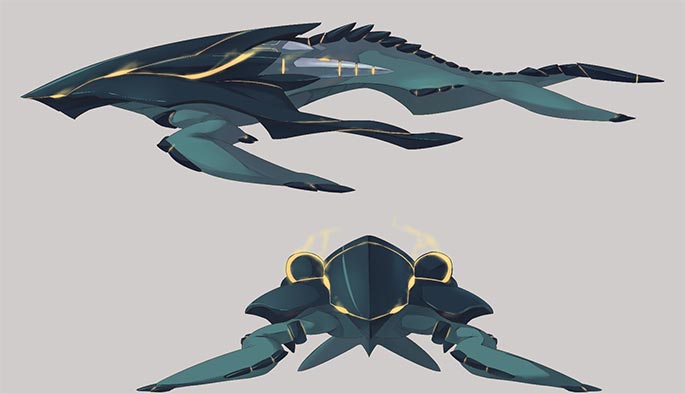
Or what should be titled, Abyssal unit design.
One particular point that sometimes come up in discussion is: why do the Abyssals even bother with different “classes” of ships?
“After all, they’re a bunch of giant fish-like monsters, right? Why not make a unit as powerful as possible, and just send that one down?”
The answer here lies in scattered pieces of evidence about what happens after an Abyssal invasion succeeds, and that humanity is eradicated. There was plenty of things we wanted to put into OCEAN, but in the end, we ended up cutting almost all of it.
In that particular short, for all intent and purposes, the Abyssals (in the only known instance where there is some recollection about what might happen) strips the planet bare of all life and leaves a ruined planet behind. In that one instance, the only things left are the “corpses” of the Abyssals left behind.
Corpses, you say, wait a minute. Abyssals don’t leave corpses. They dissipate after they are killed. And you are absolutely correct.
Yet there they are. “Dead.” Inert. Lifeless. Whatever you want to call it. They were as lifeless and still as the planet that they had taken. The Abyssals are expendible towards the goal of the Abyssal fleet. So long as the goal – annihilation – is achieved, it doesn’t matter what happens to them after. The “intelligence” is not interested in recycling its fighting units. In fact, think of Abyssal deployment as something like firing a rocket or missile. Once the Abyssal is warped “planetside,” there is no way to recover it. Either the Abyssals don’t know how, or they don’t want to.
In either case, does it really matter?
If it isn’t clear at this point, the reason why this was made a pertinent point is that we wanted to highlight the utterly deprived mindset of the antagonists of Pacific. Their goal isn’t even resources or evolution like say, the Tyranid hive fleet from 40k. It’s destruction, pure and simple.
The stuff they do to people? That’s just an added bonus to their goals.
So far, the reader does not know where the Abyssals come from. Presumably they have a “home” dimension somewhere, or some sort of home base for them to teleport in more troops. Presumably, based on the rather cautious way in which the Abyssals first move in scouting units to study the planet before delivering a crippling blow with its main forces, that the Abyssal “war mind” or “hive mind” or “intelligence” thinks about conflict in a way similar to we do: minimize the amounts of resources used to achieve the largest results.
Assume, for an instance, that there are indeed parallel universes or parallel dimensions (as it appears to be the case in the Pacific universe). This means that the Abyssals are fighting on multiple fronts at a time. In a world without shipgirls, that’s operating at say, 16th century technology levels, it probably wouldn’t take more than a few scouts to eradicate the planet.
An earth that’s say, our modern world today, with our level of military technology, might require a small “task-force” sized number of units. It would depend on how quickly we, Russia, China, and co. exhaust our nuclear arsenals, too.
An earth like Pacific’s? Well, this is where the big guns might need to come into play. It’s also where you are likely to see the largest variety of unique or unusual Abyssal units. To the Abyssal, its goal is to destroy humanity. There are many ways that could be accomplished that doesn’t involve say, a lowly scout shooting or eating everything it comes across.
Take the above unit, for instance. Its basic shape dictate that it’s basically a scout-level unit. However, it carries no armaments that are visible. The only thing you can see are the two gas canisters that it carries on its back.
This particular Abyssal catalyzes a sort of toxin using the seawater itself as a source. It’s capable of creating a very dense, albeit temporary hallucinogenic and toxic cloud that even shipgirls will become susceptible to should they remain exposed for long enough.
Does it have weaknesses? Of course. It cannot affect anything underwater, so in theory a shipgirl can simply enter the waters to evade its effects. It is also completely unarmed save for the canisters, so it’s easy pickings for any shipgirl that engages it. The mists itself seem to be closely tied with the Abyssal as well – if you kill it, the mist goes away with it. Finally, it can only “launch” two smokescreens before it must enter the regenerative mode that many Abyssals have to recoup its combat operations. Most of the time this thing’ll simply be swimming around and “dumping” its toxins in a small area, not dissimilar to how WW2 destroyers make smoke.
Where applicable, these things may accompany larger Abyssal units at large and provide either cover on the high seas, or provide a smokescreen should things turn out badly. That’s actually their (author-intended) function. It’s their “role” in the Abyssal fleet.
Yet, despite all this, think about what this thing is capable of. Applied to conventional civilians or non-combat assets and it’s strictly a terror weapon. Imagine it launching a canister into any seaside city. The casualties would be unthinkable.
This is why STEC has a hard job. With the capabilities of the shipgirls on hand, STEC’s first goal is to eradicate the Abyssal threat. In doing so, however, it must consider next how to minimize the harms caused to the very people and country it’s meant to protect. Every Abyssal, no matter how small or insignificant, has the potential to cause catastrophically large number of casualties.
It wouldn’t be much of a victory if there’s almost nobody left to celebrate and to rebuild, no?
